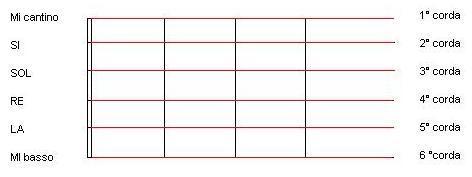THE STRINGS OF A GUITAR
We all know that there are seven musical notes: Do – Re – Mi – Fa – Sol – La – Si.
The strings on the guitar are instead only six. Because ?
Each guitar string can generate multiple notes, starting with the sound in which the string is tuned through the tuning.
Then, by pressing the various keys, you can obtain all the notes starting from the initial one, following the correct sequence.
It is essential to remember that the numbering starts from the bottom, since the lowest and thinnest string is always the first.
The hardest thing to remember is the fact that the numbering starts from the bottom and not from the top.
Starting with the thinnest, or 1st string, the order would be E-B-G-D-A-E:
1 string: E – “high E string” (italian: ‘Mi cantino’)
2 string: B – (italian: SI)
3 string: G – (italian: SOL)
4 string: D – (italian: RE)
5 string: A – (italian: LA)
6 string: E - “low E string” (italian: MI)
The thickest string is called the 6th string.
In standard guitar tuning, this is tuned to E and is often referred to as the “low E string” meaning the lowest note you can play.
Then moving down the fretboard, the 5th string (the A string) is tuned to A, the 4th string (D string) is tuned to D, the 3rd string (G string) is tuned to G, the 2nd string (B string) is tuned to B and the 1st string (“high E string”) is tuned to E.
The E – “high E string” and the E - “low E string” are two identical notes but of two different octaves: the E – “high E string” is found on the finest string and produces the highest sound; the other ‘E’ is instead often referred to as “low E string”.
THE IMPORTANCE OF STRINGS IN THE GUITAR
The strings in a guitar are very important and, periodically, they must be replaced: it is not enough to have a quality instrument and good amplifiers but it is necessary to pay attention to the quality of the material and of the ‘gauge’.
When we talk about ‘gauge’ we refer to the thickness of the string, usually measured in inches.
The gauge of the strings ranges from a thickness of 0.08 to a maximum of 0.60 for the last string.
The strings for classical guitar
Classical guitars use nylon strings only and it is very important to choose a certain tension, as it determines the type of sound.
The most common voltages are: low / light, moderate medium and hard / high.
Among the best known and highest quality brands of classical guitar strings are: D’Addario, Savarez, Martin, and Ernie Ball.

